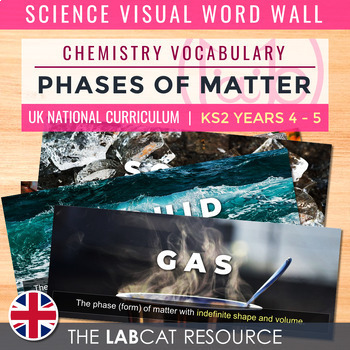PHASES OF MATTER | Science Visual Word Wall (Chemistry Vocabulary) [UK]
- Google Drive™ folder
- Easel Activity

Also included in
- Create a visually-stimulating and concept-forming learning environment with these stunning visual word walls!Enhance the learners' conceptualisation and schema-forming capabilities with text-editable visual word walls. It comes with a wide variety of size, printing options, and format options. FeatuPrice $7.50Original Price $9.00Save $1.50
Description
Create a visually-stimulating and concept-forming learning environment with these stunning visual word walls!
Enhance the learners' conceptualisation and schema-forming capabilities with text-editable visual word walls. It comes with a wide variety of size, printing options, and format options. Featured with high quality background images, this product would surely make science vocabulary words easier to recall and conceptualise.
Features:
- Editable texts
- High-quality images
- Visually-stimulating
- Highly flexible
- Level-appropriate definitions
- Highlighted keywords
- Includes printing instructions
- In British English
Alignment:
If you are in the Philippines, then this includes grades 3 to 5 level vocabulary, and is fully aligned with the PH K12 Curriculum:
- S3MT-Ic-d-2: Classify objects and materials as solid, liquid and gas based on some observable characteristic;
- S3MT-Ie-g-3: Describe ways on the proper use and handling of solid, liquid, and gas found at home and in school;
- S3MT-Ih-j-4: Describe changes in materials based on the effect of temperature;
- S4MT-Ig-h-5: Describe changes in properties of materials when exposed to certain conditions such as temperature or when mixed with other materials;
- S5MT-Ic-d-2: Investigate changes that happen in materials under the following conditions: presence or lack of oxygen, application of heat.
If you are in the USA, then this includes grades 2 to 5 level vocabulary, and is fully aligned with the NGSS:
- 2-PS1-1: Plan and conduct an investigation to describe and classify different kinds of materials by their observable properties;
- 2-PS1-4: Construct an argument with evidence that some changes caused by heating or cooling can be reversed and some cannot;
- 5-PS1-2: Measure and graph quantities to provide evidence that regardless of the type of change the occurs when heating, cooling, or mixing substances, the total weight of matter is conserved.
If you are in England, UK, then this includes years 3 to 5 level vocabulary, and is fully aligned with the National Curriculum for Science:
- Year4, States of Matter - 1: Compare and group materials together, according to whether they are solids, liquids, or gases;
- Year 4, States of Matter - 2: Observe that some materials change state when they are heated or cooled, and measure or research the temperature at which this happens in degrees Celsius;
- Year 4, States of Matter - 3: Identify the part played by evaporation and condensation in the water cycle, and associate the rate of evaporation with temperature;
- Year 5, Properties and Changes of Materials - 5: Demonstrate that dissolving, mixing, and changes of state are reversible changes.
Included Vocabulary:
The 15 vocabulary words are divided into 3 classifications for easier differentiation.
- Basic (solid, liquid, gas, fluid, phase change)
- Intermediate (plasma, melting, solidification or freezing, evaporation, condensation)
- Advanced (boiling point, melting point, freezing point, sublimation, deposition)
Size Variations:
- A4 (full landscape, half crosswise, half lengthwise)
- Index Card (3" x 5")
Text Options:
- Vocabulary word only
- With Definition
Formats Included:
- Printable
- Presentation
- Interactive Slides
- Easel
Available Product Variations:
- Classic Word Wall in American English
- Classic Word Wall in British English
- Visual Word Wall in American English
FOLLOW ME!
Click the green star under THE LABCAT RESOURCE's shop name to get updates on new products, sales, and more!
EARN TPT CREDITS!
TPT credits can be used to lower the cost of your future purchases. If you have already bought this product, go to My Purchases page and click on Provide Feedback found beside this product.







